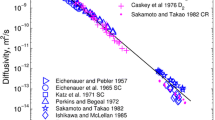Summary
-
1.
An investigation was made of the effect of temperature on the limiting diffusion current and the thickness of the diffusion layer at copper, iron, and amalgamated copper electrodes in stirred and unstirred solutions of sodium chloride and ferric chloride.
-
2.
In unstirred electrolytes at constant oxygen concentration the limiting diffusion current increases with temperature. When the concentration of oxygen changes as a result of reduction of solubility with rise in temperature, the limiting current attains its maximum value at 80° and then falls.
-
3.
In a stirred electrolyte the thickness of the diffusion layer increases with rise in temperature. In unstirred electrolytes δ diminishes with rise in temperature as a result of increased convectional mixing.
-
4.
At iron and copper in N NaCl oxygen is reduced partly to hydrogen peroxide and partly to hydroxyl ions.
Similar content being viewed by others
Literature cited
G. V. Akimov, Theory and Methods of Investigation of the Corrosion of Metals (Acad. Sci. USSR Press, Moscow and Leningrad, 1945).
N. D. Tomashov, Corrosion of Metals with Oxygen De polarization. (Acad. Sci. USSR Press, Moscow and Leningrad, 1947).
A. N. Frumkin, V. S. Bogotsky, Z. A. Iofa and B. P. Kabanov, Kinetics of Electrode Processes (Moscow Univ. Press, 1952).
A. I. Krasilshchikov, J. Plays. Chem. 23, 332 (1949).
V. G. Levich, Physicochemical Hydrodynamics (Acad. Sci. USSR Press, Moscow, 1953).
Yu. G. Siver and B. P. Kabanov, J. Plays. Chem. 22, 53 (1945); 23, 43 (1949).
I. M. Kolthoff and C. S. Miller, J. Am. Chem. Soc. 63, No. 3, 1013 (1941).
Handbook of Chemistry (State Chem. Press, Moscow, 1951), Vol. 3.
W. Breckheimer, I. D' Ans, Werkstoffe and Korrosion 5, No. 2, 43 (1954).
M. Torre, An. Asoc. Equim. Argentina 3, 8 (1915).
S. N. Krichmar, Proc. Acad. Sci. USSR 100, No. 3, 484 (1955).
P. N. Kovalenko, J. Appl. Chem. 23, No. 10, 1066 (1950) (T.p. 1131).
E. Brunner. Z. phys. Chem, 47, 56 (1904).
Author information
Authors and Affiliations
Rights and permissions
About this article
Cite this article
Gerasimov, V.V., Rozenfeld, I.L. Effect of temperature on the diffusion current and the thickness of the diffusion layer. Russ Chem Bull 5, 797–801 (1956). https://doi.org/10.1007/BF01169982
Received:
Issue Date:
DOI: https://doi.org/10.1007/BF01169982




